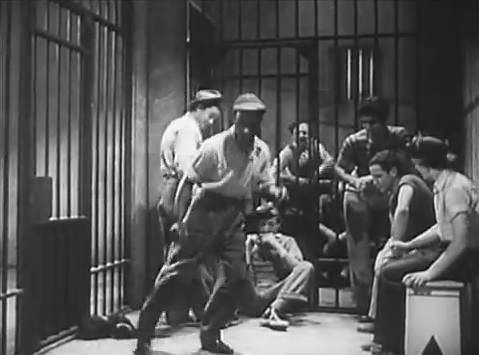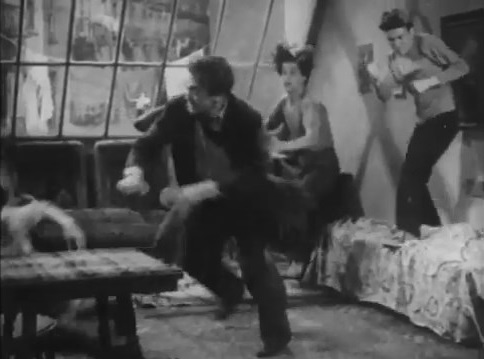Bowery
Blitzkrieg
Loss of the
Golden Gloves to racketeers.
This is something
for the East Side Kids, it costs blood.
Some of the
funniest gags thereabouts, witness the apple cart.
The Corpse Vanishes
Fox is inspired
for most of this film, and produces frissons that have nothing to do with
genre. It may be he had just seen Dreyer’s Vampyr, or perhaps he was struck with the essence of
Lugosi, in a close-up, taking it all in. At any rate, this hour or so, before
Dr. Foster tells all (Fox goes out for a smoke in this scene, and only comes
back to film the girls, before the ingenious finale works things out) is
unanalyzable moviemaking of the richest, a wonderful sustained inspiration. Dr.
Lorenz speaks to the Countess, then he ascends the staircase from lower right
to upper left as she turns and walks right to left, the camera tracks on her as
he rises out of sight, then she opens a side door in the staircase and
disappears into it. Is it the fluid rhythm of this, or the tempo? Foster and
Patricia are conversing in close reverse shots, under the dialogue you begin to
hear a train bell, they’re at the depot, waiting for the train, Fox cuts
to it, at a sharp angle, coming into the station. What is there in all this,
but something more than the sum of its parts?
Amid echoes of
Julian’s Phantom of the Opera
and Whale’s The Bride of
Frankenstein, a humorous reflection of Hawks’ His Girl Friday.
Let’s Get Tough!
A rollicking film
with a vaudeville turn yet, that keeps Fox on the go every minute and keeps
emerging with new material all the time, featuring a haunted-house transition
and a surreal conclusion at the conventicle of the secret society of saboteurs.
Smart
Alecks

“And they
call that the better half.”
“Better
half, there’s two o’
them!”
A member of the
club goes bad for a “sack o’ potatoes” and some lettuce.
“This guy
eats like Hitler was in Brooklyn.”
“Hello
gorgeous, ya like to join my ball team?”
Homage to Wyler.
TV Guide, “the usual wisecracks”. Leonard Maltin, who misunderstands the plot, “undernourished entry.” Hal Erickson (All Movie Guide), likewise, “second-rate entry”.
Bowery at Midnight
This is where
Lang’s Dr. Mabuse meets Buñuel’s Viridiana in
one of those surprising developments that revise a whole way of thinking, like
the discovery that Méliès and Keaton are linked by Griffith. Fox relies on
straight propulsion to carry him through the horrors on an even keel, and the
excellent script has beautiful humorous touches.
‘Neath Brooklyn Bridge

“It’s
an architecterial masterpiece.”
The dominion of
crime, a silent witness.
“Whadda you do, make those notes in shorthand? You do it
awful fast—so, you been drawin’ PICTURES all these years?”
High hats,
“war profiteers”, soup to nuts. A source of Hogan’s Heroes in the girl emerging disguised from the
trapdoor in the clubhouse (“that rule has been retrieved for the
temporary time”).
Kid Dynamite

East Side vs.
West Side, in current conditions. “Look, this time go in and give him a right
cross, a left cross, then give him a Japanese uppercut!”
“A Japanese
uppercut?”
“Yeah, a double cross.” The
other guy don’t play fair, and you ain’t supposed to be playing
anyway, says Mrs. Lyons. A great, elastic study of the
war, with one of the great fights on film, and a jitterbug contest. “You
mean to say those Nazis just walked in and snuffed out a whole town just like that?” Muggs has the villain’s part on the Hawks Scarface theme
but finally joins the Navy to fight alongside Glimpy
(Marines) and Danny (Army).
Cf.
Edgar G. Ulmer’s Tomorrow We Live,
George Sherman’s X Marks the Spot.
Leonard Maltin, “rambunctious”.
TV Guide, “so-called comedy”.
The Great Mike
A bold, exciting
film, because Fox out of doors relies on natural compositions that build up
easy, sonorous implications of rhythm. Only Fritz Lang in Scarlet Street in the studio has this
kind of eye at this time. The freshness lasts right into the sound stage, and
puts this film all told a good ten or fifteen years ahead of its time, as well
as among the best of its time.
Pillow of Death
A film that can
only by understood backwards, starting at the end. This has proven too
difficult for critics in any event, if you call Bosley Crowther a critic.
Then the wartime
allegory, set up early on, becomes quite clear. The odd jumble of assortments
more or less noted by critics in after times is a feature of style akin to Max
Ernst.
The staggering
boldness of the compositions, the dreamlike apparitions of matter-of-fact
bodies, the upending of stylistic understandings principally to do with the
occult, these are things beyond the ken of scribblers.
Fox exhibits a
swirling vigor of style at the outset, before settling in among the jewel-like
settings which are quite capacious, as customary with an Inner Sanctum mystery.
The Gay Amigo
The great
director of The Great Mike
is, not surprisingly, greatly at home among horses and sunlight. The serenity
of his flawless technique just floats along in tracking shots, and is based on
a thorough knowledge of the whole range of equine films.
Cisco and Pancho
are philosophizing on the U.S./Mexican border, “sometimes what you do not
see is more there than what you do see.” Before they know it,
they’re mistaken by a U.S. Army patrol for members of a terrible Mexican
gang. However, The Cisco Kid has learned those aren’t Mexicans at all,
but Americanos in disguise.